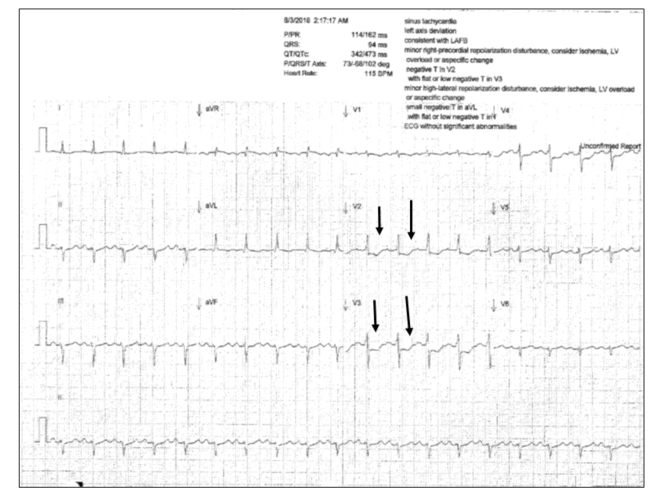Differential Diagnosis
- Anterior myocardial infarction
- Subendocardial ischemia
- Posterior myocardial Infarction
- Left Anterior fascicular block
- Supraventricular tachycardia

Diagnosis
The ECG shows marked ST depression in chest leads V2, V3, and V4. This patient had a posterior myocardial infarction. Immediately he received oral fluids, aspirin, and albuterol nebulizer treatments but showed no significant improvement. Nitroglycerin 0.4 mg was not given due to low blood pressure because of the likelihood of having right heart myocardial infarction. ECG was repeated EKG after 15 minutes and showed no improvement.
The patient was transferred and admitted to the hospital for further evaluation and treatment. There, catherization showed four vessels blocked, leading to open heart surgery.
Learnings/What to Look for
- Be alert for ST-depression in the anterior leads of V1-V3 since these leads directly face the posterior wall of the left ventricle
- Other signs include:
- Large R-waves in leads V1-V2
- R:S >1 in either V1 or V2
- Often, there will be large and upright anterior T waves
- There may be subtle signs of inferior or lateral MI; look for ST elevation in other corresponding leads
Pearls for Urgent Care Management and Considerations for Transfer
- Probe for signs of MI, including chest discomfort, shortness of breath, diaphoresis, and dizziness, as well as hemodynamic instability (eg, hypotension, dizziness, confusion)
- If symptomatic in the urgent care, give oxygen support, aspirin, 0.4 mg sublingual nitroglycerin, and morphine if chest pain continues
- Do a mirror image challenge and look at leads V1-V4 by turning the ECG readings 180° and putting the readings up to the light. The tall anterior R-waves become deep posterior Q-waves, the ST-depression becomes ST-elevation, and upright T-wave becomes terminal T-wave inversion
- Do not give nitroglycerin to patients who are hypotensive
- All patients presenting to the urgent care with a posterior MI will need emergent transfer to a cardiac catherization lab
Acknowledgment: Case submitted by Sudhir R. Gogu, DO, PhD, MBA.

